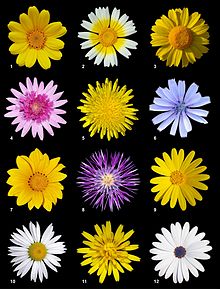Asteraceae
The "Scots" that wis uised in this airticle wis written bi a body that haesna a guid grip on the leid. Please mak this airticle mair better gin ye can. (Mairch 2021) |
| Asteraceae | |
|---|---|

| |
| Twal species o Asteraceae frae the subfaimilies Asteroideae, Carduoideae an Cichorioideae | |
| Scientific classification | |
| Kinrick: | Plantae |
| Clade: | Angiosperms |
| Clade: | Eudicots |
| Clade: | Asterids |
| Order: | Asterales |
| Faimily: | Asteraceae Bercht. & J.Presl[2] |
| Teep genus | |
| Aster | |
| Subfaimilies | |
| |
| Diversity | |
| 1,911 genera | |
| Synonyms[3] | |
| |
Asteraceae or Compositae (commonly referred tae as the aster, gowan, or sunflouer faimily), is a ower lairge an widespread faimily o Angiospermae.[4][5] The group haes mair nor 23,000 currently acceptit species, spread athort 1,620 genera (leet) an 12 subfaimilies. In terms o nummers o species, Asteraceae is rivaled anly bi Orchidaceae.[4][6] (The whilk o the twa faimilies is actually lairger isna clear, awin tae uncertainty aboot exactly hou mony species exist in each faimily). The main featur o the faimily is the composite flouer type in the fairm o capitula surroondit bi involucral bracts.The name "Asteraceae" comes frae Aster, the maist prominent genus in the faimily, that derives frae the Greek ἀστήρ meanin starn, an is connectit wi its inflorescence starn fairm. As for the term "Compositae", mair ancient but still valid, it obviously maks reference tae the fact that the faimily is ane o the few angiosperms that hae composite flouers.[7] This faimily haes a remarkable ecological an economical importance, an is present frae the polar regions tae the tropics, colonizin aw available habitats. The Asteraceae mey represent sae muckle as 10% o autochthon flora in mony regions o the warld.
Maist members o Asteraceae are yerbaceous, but a significant nummer are an aa shrubs, vines an trees. The faimily haes a warldwide distribution, an is maist common in the arid an semi-arid regions o subtropical an lawer temperate latitudes.[8]
Asteraceae is an economically important faimily. Some members provide products includin cuikin iles, lettuce, sunflouer seeds, artichokes, sweetenin agents, coffee substitutes an yerbal teas. Several genera is popular wi the horticultural community, includin marigowd, pot marigowd (forby kent as calendula), cone flouers, various gowans, fleabane, chrysanthemums, dahlias, zinnias, an heleniums. Asteraceae are important in yerbal medicine, includin Grindelia, echinacea, yarrow an mony ithers.[9] A nummer o species hae come tae be considered invasive, includin, maist notably in North Americae, dandelion, whilk wis oreeginally introduced bi European settlers wha uised the young leafs as a salad green.[10]
References
[eedit | eedit soorce]- ↑ Viviana D. Barreda; Luis Palazzesi; Maria C. Tellería; Eduardo B. Olivero; J. Ian Raine; Félix Forest (2015). "Early evolution of the angiosperm clade Asteraceae in the Cretaceous of Antarctica". Proceedings of the National Academy of Sciences of the United States of America. 112 (35): 10989–10994. doi:10.1073/pnas.1423653112. PMC 4568267. PMID 26261324.
- ↑ Template:Tropicos
- ↑ "Family: Asteraceae Bercht. & J. Presl, nom. cons". Germplasm Resources Information Network (GRIN). USDA, ARS, National Genetic Resources Program, National Germplasm Resources Laboratory, Beltsville, Maryland. Archived frae the original on 23 September 2015. Retrieved 12 Juin 2008.
- ↑ a b Stevens, P. F. (2001 onwards) Angiosperm Phylogeny Website. Version 9, June 2008 http://www.mobot.org/mobot/research/apweb/welcome.html
- ↑ Jeffrey, C. 2007. Compositae: Introduction with key to tribes. Pages 61-87 in Families and Genera of Vascular Plants, vol. VIII, Flowering Plants, Eudicots, Asterales (J. W. Kadereit and C. Jeffrey, eds.). Springer-Verlag, Berlin
- ↑ Panero, J.L., Crozier, B.S. Tree of Life - Asteraceae http://tolweb.org/Asteraceae/20780 Archived 2011-06-26 at the Wayback Machine
- ↑ International Code of Botanical Nomenclature. In point 18/5 states: "The following names, uised traditionally, is considered valid: Compositae (Asteraceae...).
- ↑ Barkely, T.M., Brouillet, L., Strother, J.L. (2006) Flora of North America - Asteraceae" http://www.efloras.org/florataxon.aspx?flora_id=1&taxon_id=10074
- ↑ "Dr. Duke's Phytochemical and Ethnobotanical Databases". Archived frae the original on 24 Julie 2013. Retrieved 5 Julie 2013.
- ↑ "dandelion Taraxacum officinale". Invasive Plant Atlas of the United States. Retrieved 10 September 2012.
Freemit airtins
[eedit | eedit soorce]- Compositae at The Plant Leet Archived 2019-05-23 at the Wayback Machine
- Compositae Archived 2009-07-03 at the Wayback Machine at The Faimilies o Flouerin Plants (DELTA) Archived 2007-01-03 at the Wayback Machine
- Asteraceae at the Encyclopedie o Life
- Asteraceae at the Angiosperm Phylogeny Wabsteid
- Asteraceae Archived 2011-06-26 at the Wayback Machine at the Tree o Life Wab Project
- Asteraceae at the online Flora o North Americae
- Asteraceae at the online Flora o Pakistan Archived 2008-09-30 at the Wayback Machine
- Asteraceae at the online Flora o Zimbabwe
- Compositae at the online Flora o Taiwan
- Asteraceae Archived 2013-05-06 at the Wayback Machine at the online Flora o Wastren Australie Archived 2013-07-04 at the Wayback Machine
- Compositae at the online Flora o New Zealand
- The Internaitional Composite Alliance (TICA) A warldwide group o composite seestematists
| This plaunt-relatit airticle is a stub. Ye can help Wikipaedia bi expandin it. |
